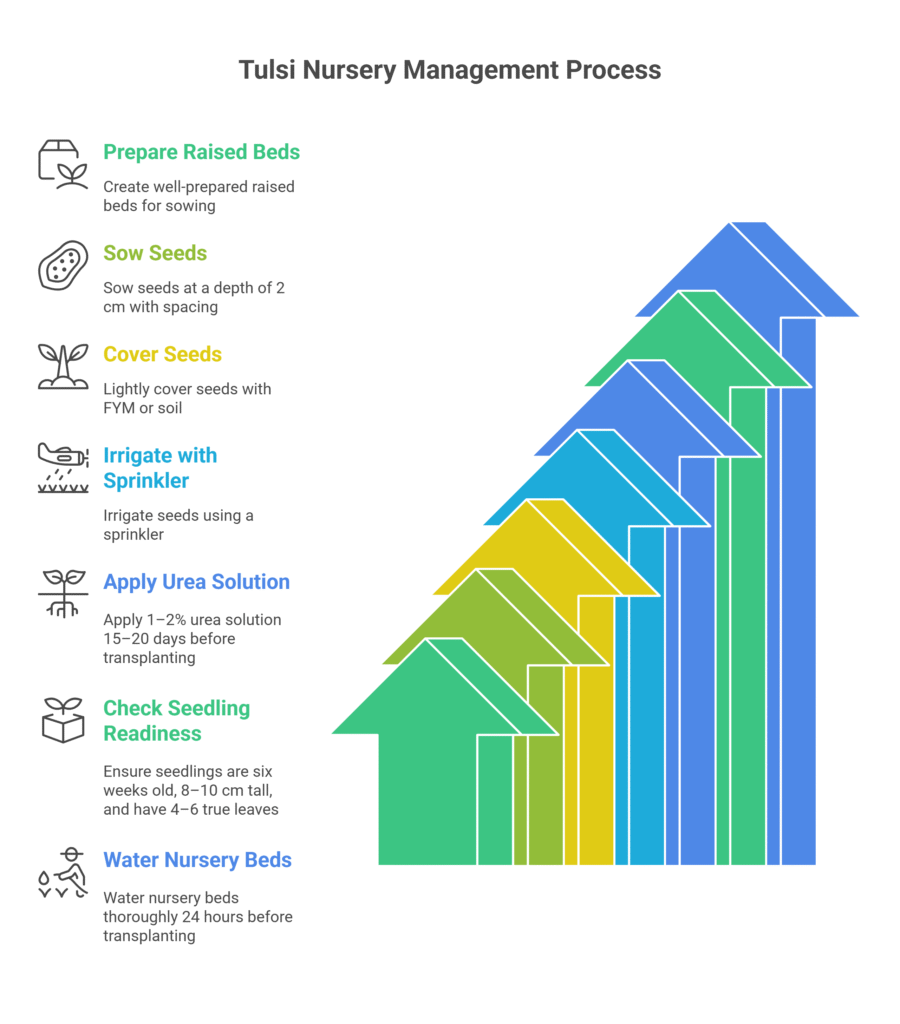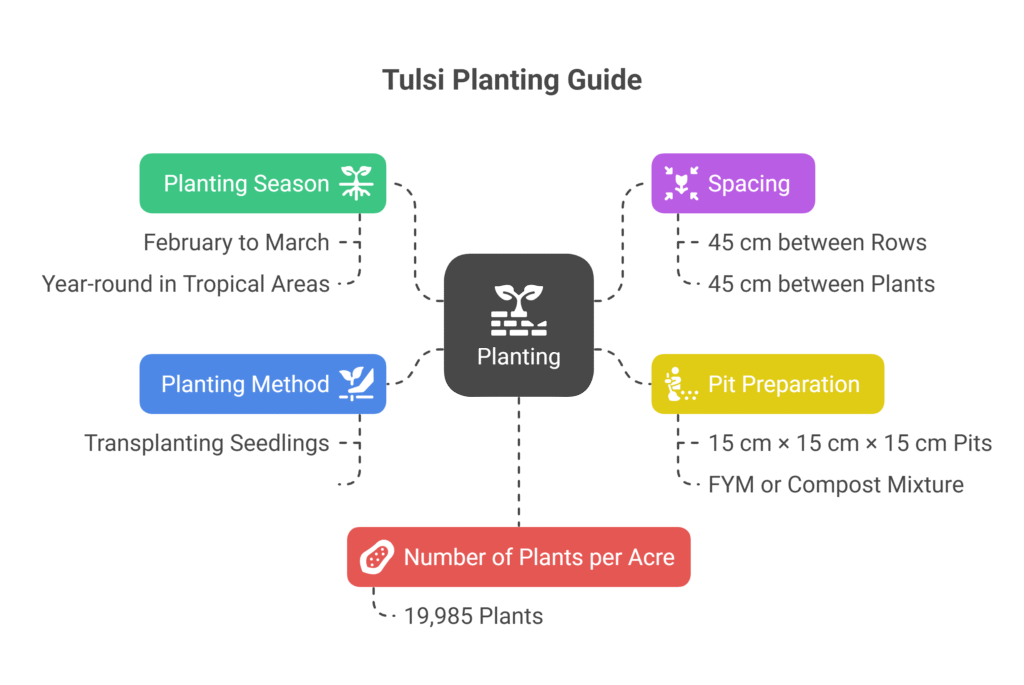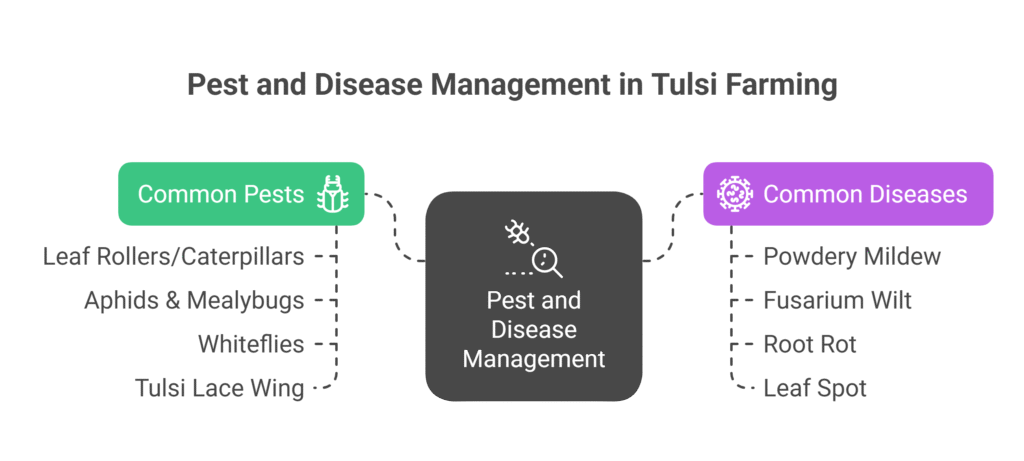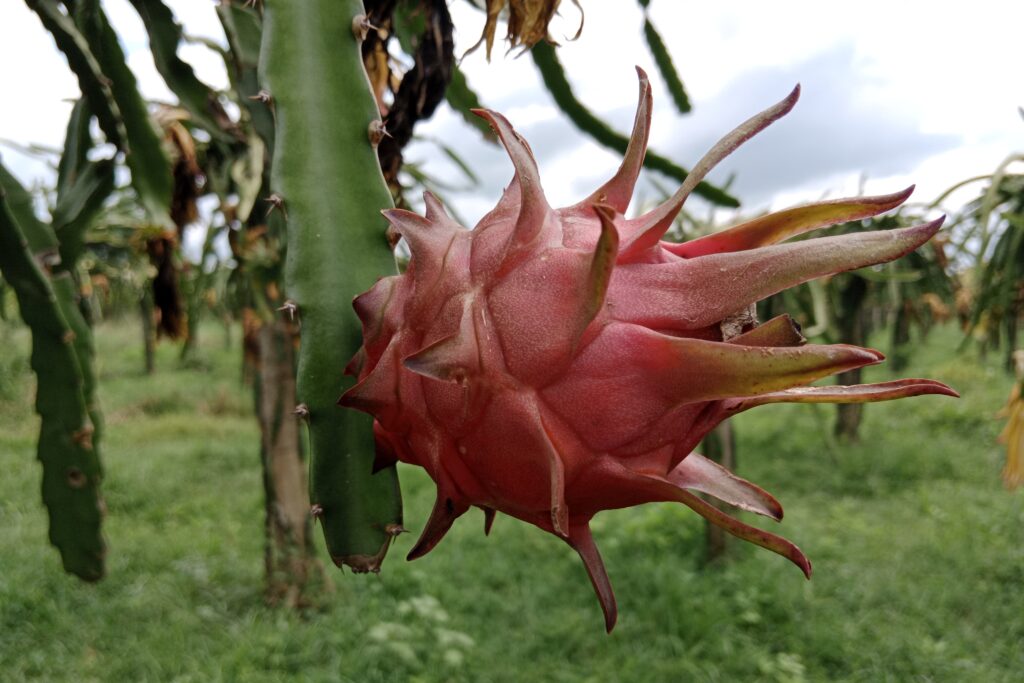Tulsi Farming
Tulsi (Ocimum sanctum), revered as Holy Basil, is a widely cultivated aromatic shrub (2-4 feet tall) valued for its religious significance, medicinal properties, and ability to purify air. Its extracts treat stress, fever, inflammation and enhance stamina due to antimicrobial and antiviral qualities. Tulsi Farming Profit Per Acre demonstrates exceptional financial viability, evidenced by an investment of NRs. 34,500 per acre generating NRs. 350,000 revenue from the sale of 5,000 kg of fresh leaves at NRs. 70/kg. This results in a net profit of NRs. 315,500, translating to a robust 90.14% profit margin and a remarkable 914.49% Return on Investment (ROI), showcasing its high-income potential per acre.

Land Preparation
Land preparation requires starting with a clean, weed-free field. This process begins with deep ploughing (20-25 cm) to break up hard soil layers, followed by 2-3 cross harrowings or discings to pulverize the soil into a fine tilth. Well-decomposed Farmyard Manure (FYM) or compost (8-10 tonnes/acre) should be incorporated during the last ploughing. The field must then be properly leveled to ensure uniform irrigation and prevent waterlogging; additionally, if drainage is a concern, raised beds or ridges and furrows should be prepared.
Soil Type
Tulsi (Holy Basil) flourishes in fertile, well-drained soils, with sandy loam to loamy textures being optimal for root development and moisture management. While adaptable to a range of pH levels, it achieves its most vigorous growth and essential oil production in slightly acidic to neutral soils, specifically within a pH range of 6.0 to 7.5. Heavy clay soils that retain excess water and cause waterlogging, as well as highly saline or alkaline soils, are unsuitable and should be strictly avoided, as they hinder root function and overall plant health.
Climatic Requirements
| Climatic Factor | Requirement | Notes/Importance |
| Climate Type | Warm, tropical to subtropical | Optimal growing environment |
| Sunlight | Full sun exposure | Best for growth and essential oil production |
| Temperature | 20°C to 30°C | Frost is detrimental; avoid exposure |
| Humidity | Moderate to high | Especially critical during the initial growth phase |
| Rainfall | 600 – 1000 mm (annual) | Generally suitable |
| Irrigation | Supplemental during dry periods | Essential to maintain moisture if rainfall is insufficient |
Major Cultivars
| Cultivar Name (Common) | Botanical Name | Key Characteristics | Primary Regions Found | Key Uses & Properties |
| Krishna Tulsi | Ocimum tenuiflorum | Dark purple stems/leaves, strong clove-like aroma | Throughout India | Highly valued in Ayurveda; rich in vitamins/minerals; source of mosquito-repellent & anti-malarial Tulsi oil |
| Rama Tulsi | Ocimum tenuiflorum | Green stems/leaves, milder aroma than Krishna | Cultivated widely | Important medicinal properties |
| Vana Tulsi | Ocimum gratissimum | Light green hairy leaves, strong clove scent; taller plant | Himalayas, plains of India; wild & cultivated | Relieves stress, boosts immunity, improves ulcer resistance; spicy fragrance |
| Kapoor Tulsi | Ocimum kilimandscharicum x basilicum | Green leaves, strong camphor aroma; easy to grow | India (ancient), USA (temperate climates) | Essential oil production, religious use, dried leaves for tea |
| Drudriha Tulsi | Not specified | Description not provided | Bengal, Nepal, Chatgaon, Maharashtra | Relieves throat dryness; heals swelling/rheumatism |
| Ram/Kali Tulsi | Ocimum canum | Purple stem, green aromatic leaves | China, Brazil, E. Nepal, Bengal, Bihar, S. India | Adaptogenic, antifungal, antibacterial, immune-enhancing; thrives in warm areas |
| Babi Tulsi | Not specified | 1-2 ft tall; 1-2 inch oval, pointed leaves; clove taste | Punjab to Trivandrum, Bengal, Bihar | Vegetable flavoring |
| Tukashmiya Tulsi | Not specified | Description not provided | Western India, Persia | Treats throat disorders, acidity, leprosy |
| Amrita Tulsi | Not specified | Dark purple leaves forming dense bushes | Throughout India | Used in treating cancer, heart disease, arthritis, diabetes, dementia |
Seed Rate per Acre
For Tulsi cultivation using nursery-raised seedlings, approximately 200 grams of seeds are required per acre. While direct sowing may use slightly more seed, transplanting is the preferred method. To prevent soil-borne diseases and pests, seeds should be treated before sowing with Mancozeb at a rate of 5 grams per kilogram of seed.
Nursery Management
For optimal Tulsi cultivation, establish a nursery by sowing seeds on well-prepared raised beds about 4–6 weeks before the planned transplanting date, or ideally two months prior to the monsoon. Sow the seeds at a depth of 2 cm with appropriate spacing, then lightly cover them with farmyard manure (FYM) or soil and irrigate using a sprinkler to maintain adequate moisture.

To encourage healthy and vigorous seedling growth, apply a 1–2% urea solution 15–20 days before transplanting. Seedlings are considered ready for transplant when they are six weeks old, approximately 8–10 cm tall and have developed 4–6 true leaves. Transplanting is typically done in mid-April, and to facilitate easy uprooting and preserve seedling turgidity, water the nursery beds thoroughly 24 hours in advance.
Planting
a) Planting Season
Planting is typically done from February to March in most regions; however, in frost-free tropical areas, planting can be carried out year-round with the support of irrigation.

b) Spacing
The recommended spacing for planting is 45 cm between rows and 45 cm between plants.
c) Pit Preparation
Small pits of size 15 cm × 15 cm × 15 cm are dug at the marked spacing points and filled with a mixture of topsoil and 1–2 kg of well-decomposed FYM or compost before transplanting.
d) Planting Method
Transplanting seedlings is the most common and reliable planting method, where seedlings are carefully uprooted from the nursery—preferably in the evening—their roots dipped in a 0.1% Bavistin solution for disease prevention, and then planted into the prepared pits, followed by light irrigation; direct sowing is less common due to the small seed size and uneven crop establishment.
e) Number of Plants per Acre
With a spacing of 45 cm × 45 cm, approximately 19,985 plants can be accommodated per acre.
Intercropping
Tulsi can be successfully intercropped during the initial 2–3 months with short-duration crops such as chillies, tomatoes, onions, garlic, radish, coriander, green gram, and black gram; however, tall or dense-canopy crops should be avoided to prevent shading, as intercropping helps maximize land use efficiency and offers additional early income.
Irrigation
Irrigation requires light, frequent applications, especially during establishment (first 4-6 weeks) and dry summers (3 per month). No irrigation is needed in the rainy season, totaling 12-15 irrigations yearly. Essential initial irrigations occur immediately after transplanting and during seedling establishment; subsequent timing depends on the season.
Maintain moderate moisture, avoiding both water stagnation (causes root rot) and severe drought. Drip irrigation is highly recommended for water efficiency and disease prevention (keeps foliage dry).
Fertilizer and Manure
Fertilizer application should ideally be based on the soil test report; however, as a general recommendation, the following doses can be applied per acre.
| Stage | Fertilizer/Manure | Details/Examples |
| Basal Dose | 8–10 tonnes FYM/Compost per acre- 24 kg Nitrogen (N)- 40 kg Phosphorus (P₂O₅)- 25 kg Potash (K₂O) | Approximate equivalent: 150 kg Urea + 250 kg SSP + 40 kg MOP (Adjust based on soil test) |
| Top Dressing | 24 kg Nitrogen (N) in two splits | 12 kg at 30–40 days after transplanting (DAT)- 12 kg after first harvest (for multi-cut systems) |
| Foliar Sprays | Micronutrient mixture or Panchagavya (0.5%) | Enhance plant growth and oil content |
Weed Control
Weed control is crucial during the first 45–60 days after transplanting, when Tulsi plants are still establishing. During this period, 2–3 shallow hoeings and hand weedings help manage weeds and improve soil aeration.
Additionally, a pre-emergence application of herbicides like Pendimethalin at 500 g a.i. per acre immediately after transplanting can effectively suppress early weed growth but should be used cautiously and by label instructions. Once the plants are well established, the Tulsi canopy itself helps suppress most weeds.
Flowering and Fruit Management
Weed control is crucial during the first 45–60 days after transplanting, when Tulsi plants are still establishing. During this period, 2–3 shallow hoeings and hand weedings help manage weeds and improve soil aeration.
Additionally, a pre-emergence application of herbicides like Pendimethalin at 500 g a.i. per acre immediately after transplanting can effectively suppress early weed growth but should be used cautiously and following label instructions. Once the plants are well established, the Tulsi canopy itself helps suppress most weeds.
Pest and Disease Management

Common Pests
a) Leaf Rollers/Caterpillars
Leaf rollers and caterpillars are significant pests of Tulsi (Holy Basil), actively chewing foliage and causing substantial damage. Effective management includes: 1) Hand-picking visible larvae during early infestation, 2) Spraying organic 0.5% neem oil solution to deter feeding, or 3) Applying targeted insecticides like Spinosad or Chlorantraniliprole at 4 kg/acre if infestations persist, using chemicals as a last resort.
b) Aphids & Mealybugs
Aphids and mealybugs damage Tulsi by sucking sap, leading to leaf curling, stunting, and honeydew secretion that promotes sooty mold. Control methods include dislodging pests with a strong water jet, applying organic neem oil spray (2-3 mL/L), or using chemical insecticide Acetamiprid (1 mL per litre of water) for severe infestations. Regular monitoring is essential.
c) Whiteflies
Whiteflies threaten Tulsi crops by sucking sap and vectoring harmful plant viruses, causing yellowing, wilting, and sooty mold from honeydew. Control integrates: 1) Installing yellow sticky traps near plants for adult monitoring/capture, 2) Spraying 0.5% neem oil to disrupt nymphs, and 3) Applying insect growth regulator Buprofezin (follow label rates) to target immature stages. Early intervention prevents outbreaks.
d) Tulsi lace wing
Green lacewing nymphs damage Tulsi by feeding on leaf tissue and depositing harmful excreta, causing initial leaf curling and potentially leading to complete plant desiccation if unchecked. For effective control, spray infested plants early with Azadirachtin (10,000 ppm concentration) diluted at 5 ml per litre of water. This organic, plant-derived insecticide specifically targets the destructive nymphal stage.
Common Diseases
a). Powdery Mildew
Powdery mildew, a widespread fungal disease, manifests as white powdery growth on Tulsi leaves, severely affecting photosynthesis and plant vigor. For control, first apply sulfur-based treatments (dust or wettable sulfur), neem oil, or Dinocap. In persistent cases, spray Mancozeb at 4 g per liter of water. Crucially, improve air circulation around plants to prevent outbreaks and reduce humidity-related spread.
b). Fusarium Wilt
A destructive fungal disease that is spread through the soil, fusarium wilt first causes lower leaves to turn yellow before developing into irreversible wilting, vascular browning, and finally plant death. Prevention is the key to effective management: applying Trichoderma viride biocontrol agents (5g/L water), solarizing the soil before planting, adopting resistant cultivars, and implementing rigorous 3-year crop rotations. Since the illness is incurable once established, it is imperative to prevent waterlogging and to remove or destroy afflicted plants very away.
c) Root Rot
Root rot, a destructive fungal disease primarily caused by waterlogging and poor drainage, leads to decayed roots, wilting, and plant death. Control requires immediate improvement of soil drainage and drenching the root zone with copper oxychloride or Carbendazim fungicides. Prevention includes strict phytosanitary practices and drenching nursery beds with Bavistin (Carbendazim) at 1% concentration to protect seedlings from blight and rot.
d) Leaf Spot
Fungal/bacterial spots. Control: Mancozeb, Copper fungicides, Streptocycline (for bacteria).
Harvesting
Harvesting Tulsi begins 90-100 days after transplanting (DAT) when plants are well-branched and just before flowering (or after pinching). Cut plants 15-20 cm above ground level using sharp sickles or harvesters, preferably on a sunny morning after dew has dried to maximize oil content and drying efficiency. Subsequent harvests can occur every 60-75 days after the first cut, depending on regrowth and plant vigor.
Yield
Yield largely depends on factors such as the cultivar used, climate conditions, soil fertility, availability of irrigation, and overall management practices.
| Yield Type | Quantity per Acre per Year | Key Details |
| Fresh Herb Yield | 8,000 – 10,000 kg | Achieved with 3-4 harvests under good management |
| Dry Leaf Yield | 1,600 – 2,500 kg | Based on 4:1 to 5:1 fresh-to-dry ratio |
| Essential Oil Yield | 40 – 100 kg | Varies by cultivar (0.5% – 1.0% of fresh weight) |
Cost of Investment per Acre for Tulsi Farming
| S.N. | Categories | Cost for Investment (NRs.) |
| 1 | Land Preparation (plowing) | 10,000 |
| 2 | Seed cost | 500 |
| 3 | Nursery Management | 2,000 |
| 4 | Transplanting | 2,000 |
| 5 | Fertilizers and Manure | 4,000 |
| 6 | Irrigation | 3,000 |
| 7 | Weed Control (pre & post-emergence) | 2,000 |
| 8 | Pest & Disease Control | 3,000 |
| 9 | Harvesting | 5,000 |
| 10 | Miscellaneous Costs | 3,000 |
| Total Cost | 34,500 |
Income from per Acre Tulsi Farming
| Particulars | Estimated Yield/Acre (kg) | Market Price (NRs/kg) | Total Income (NRs.) |
| Tulsi Fresh Leaves | 5,000 | 70 | 350,000 |
Analysis of Tulsi Farming Profit Per Acre
The profit analysis per acre for Tulsi farming shows a total investment cost of NRs. 34,500 against total revenue of NRs. 350,000, generated from the sale of 5,000 kg of fresh leaves at NRs. 70/kg. This results in a net profit of NRs. 315,500 (Total Revenue – Total Cost). Further profitability analysis reveals a profit margin of approximately 90.14%, calculated as (Net Profit / Total Revenue) × 100 [(315,500 / 350,000) × 100], and an exceptional Return on Investment (ROI) of approximately 914.49%, derived from (Net Profit / Total Cost) × 100 [(315,500 / 34,500) × 100].
Crop Calendar for Tulsi (Holy Basil) Farming
| Month | Key Activities | Agronomic Details |
| Dec-Jan | Nursery Establishment | · Sow seeds in raised beds (2 cm depth) with 200g seeds/acre · Treat seeds: Mancozeb @5g/kg seed · Irrigate with sprinkler; maintain moisture |
| Feb | Land Preparation Transplanting | · Deep plough (20-25 cm) + 2-3 harrowings · Apply FYM: 8-10 tonnes/acre during the last ploughing · Level field; prepare 15cm³ pits @45×45 cm spacing · Transplant 6-week-old seedlings (8-10 cm tall, 4-6 leaves) after dipping roots in 0.1% Bavistin |
| Mar-Apr | Crop Establishment Early Maintenance | · Initial irrigation: Light + frequent (drip recommended) · Pre-emergence herbicide: Pendimethalin 500g/acre · Basal dose: 24kg N, 40kg P₂O₅, 25kg K₂O + FYM · 1st top dressing: 12kg N @30-40 DAT · Intercropping: Chillies/tomatoes/onions (avoid shading crops) |
| May-Jun | Weed/Pest Control Growth Phase | · 2-3 hoeings for weed control · Monitor pests: Spray neem oil (0.5%) for aphids/leaf rollers · Foliar spray: Panchagavya (0.5%) for oil content · Irrigation: 3x/month (summer) |
| Jul-Aug | 1st Harvest Post-Harvest Care | · Harvest @90-100 DAT: Cut 15-20 cm above ground (sunny morning) · Yield: 2,500-3,000 kg fresh leaves/acre · 2nd top dressing: 12kg N after harvest · Disease control: Mancozeb (4g/L) for powdery mildew |
| Sep-Oct | 2nd Harvest Regrowth Phase | · Harvest @60-75 days after 1st cut · Monitor drainage (monsoon risk) · Essential oil peak: Maximize leaf oil content (0.5-1.0%) · Pest control: Azadirachtin (5ml/L) for lacewing |
| Nov-Dec | 3rd Harvest Overwinter Prep (Temperate regions) | · Final harvest (if 3-cut system) · Reduce irrigation as temperatures drop · Frost protection: Mulching/row covers if <20°C · Soil test for next season |
Sources
Indian Council of Agricultural Research (ICAR).
Nepal Agricultural Research Council (NARC).
Handbook of Herbs and Spices (Woodhead Publishing).
National Horticulture Board, India.
Tamil Nadu Agricultural University- Agritech portal.
Punjab Agricultural University.


